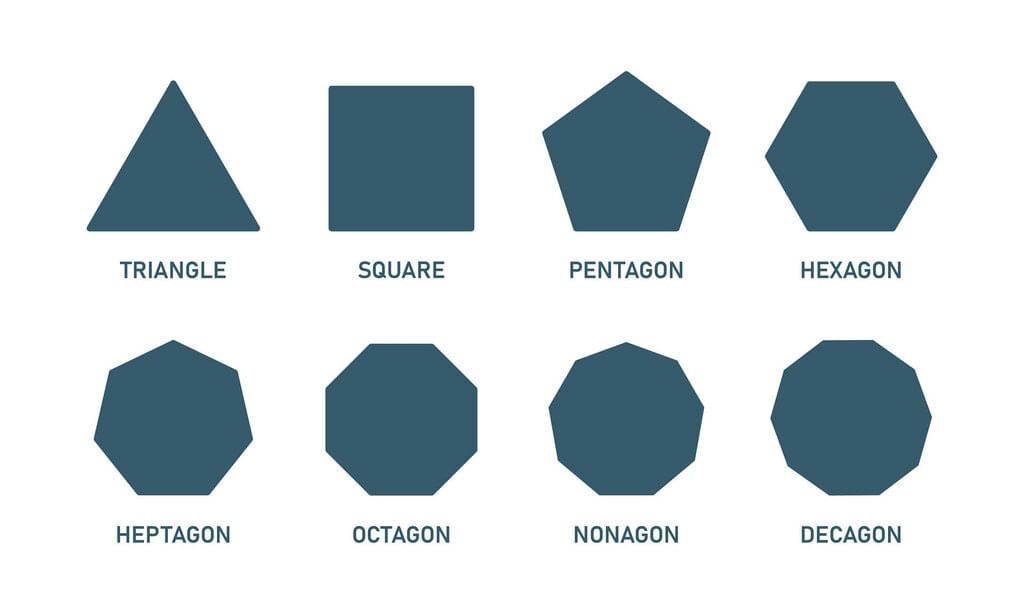Year 3 Exam > Year 3 Notes > Year 3 Mathematics > How to identify different 2D shapes
How to identify different 2D shapes | Year 3 Mathematics PDF Download
What are 2D shapes?
- 2D shapes are ubiquitous elements in our surroundings, appearing in various forms.
- For instance, windows commonly exhibit a rectangular shape, while clocks typically feature a circular design.
- These shapes are flat and possess distinct characteristics.
Properties of 2D Shapes
A property of a shape refers to a specific quality it possesses. These properties help us distinguish one shape from another. Some essential properties of 2D shapes include:
- Number of sides
- Number of vertices (corners)
- Length of sides
- Types of angles (acute, obtuse, right-angle)
- Presence of perpendicular and parallel lines
Let's examine the properties of three common 2D shapes - a triangle, a square, and a hexagon etc.:
Triangles

- All triangles consist of 3 sides and 3 angles.
- The sum of their internal angles always equals 180°.
- However, various types of triangles exist based on their properties, which include:
- Isosceles
- Equilateral
- Scalene
- Right-angled
Quadrilaterals
A quadrilateral is defined as a shape with 4 sides and 4 angles. Some examples of quadrilaterals along with their properties are:

Rectangle
- 2 pairs of equal sides.
- Angles all right-angles (perpendicular lines).
- 2 pairs of parallel lines.
Square
- A special type of rectangle.
- Sides all have equal length.
- Angles are all right-angles (perpendicular lines).
- 2 pairs of parallel lines.
Trapezium
- 1 pair of parallel lines.
- 2 sets of equal angles.
- 2 lines equal length and 2 that aren’t.
Kite
- 2 pairs of equal sides.
- 1 pair of equal angles.
- No parallel lines.
Regular Polygons

Regular polygons are shapes with all sides and angles equal. Let's explore some common examples:
Pentagon
- A pentagon has five equal sides and angles.
Hexagon
- A hexagon has six equal sides and angles, with three pairs of parallel lines.
Heptagon
- A heptagon features seven equal sides and angles.
Octagon
- An octagon consists of eight equal sides and angles, with four pairs of parallel lines.
Irregular Polygons

- Definition: Irregular polygons are shapes with sides and angles of varying sizes.
- Identification: Each polygon can be recognized by the number of sides it possesses. For instance, a pentagon always has 5 sides.
- Example:
- This irregular pentagon features sides and angles of different lengths and sizes.
- It includes two right angles and a pair of equal sides, while the other three sides have varying lengths.
Question for How to identify different 2D shapesTry yourself: Which type of polygon has sides and angles of varying sizes?View Solution
The document How to identify different 2D shapes | Year 3 Mathematics is a part of the Year 3 Course Year 3 Mathematics.
All you need of Year 3 at this link: Year 3
|
68 videos|71 docs|14 tests
|
FAQs on How to identify different 2D shapes - Year 3 Mathematics
| 1. What are 2D shapes? |  |
Ans. 2D shapes are flat geometric figures that only have length and width, such as circles, triangles, squares, rectangles, and pentagons.
| 2. What are some properties of 2D shapes? |  |
Ans. Some properties of 2D shapes include the number of sides, angles, and vertices they have, as well as their symmetry and area.
| 3. How can you identify different 2D shapes? |  |
Ans. You can identify different 2D shapes by looking at the number of sides and angles they have, as well as their unique characteristics such as right angles in squares and equilateral sides in triangles.
| 4. What are some common 2D shapes taught in UK schools? |  |
Ans. Some common 2D shapes taught in UK schools include circles, triangles, squares, rectangles, and pentagons.
| 5. What are some frequently asked questions about 2D shapes in exams? |  |
Ans. Some frequently asked questions about 2D shapes in exams include identifying shapes based on their properties, calculating the area of shapes, and determining the symmetry of shapes.
Related Searches















